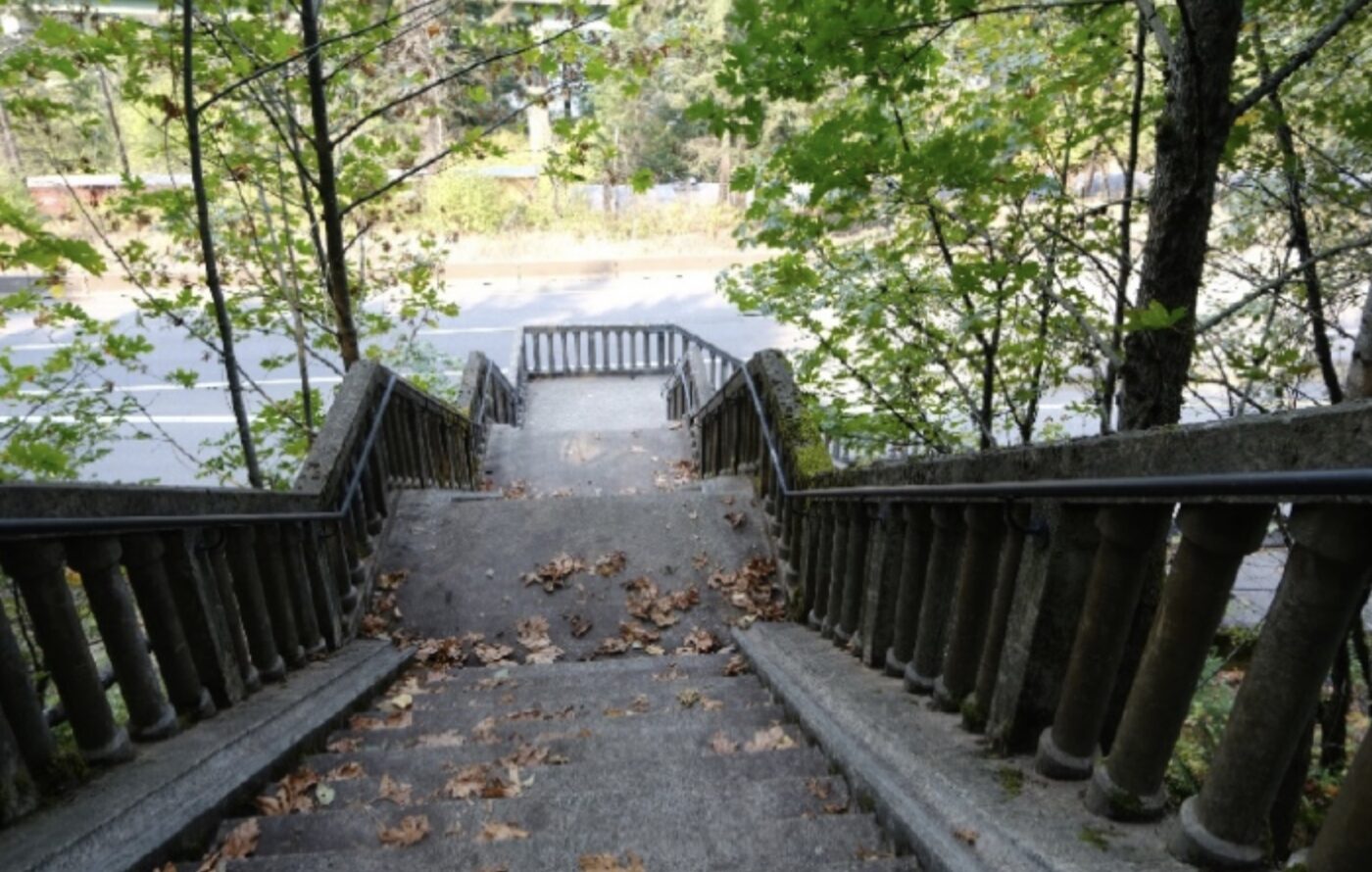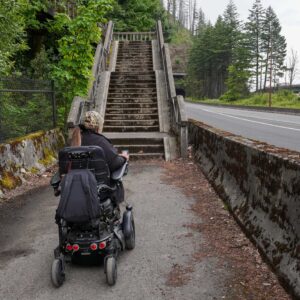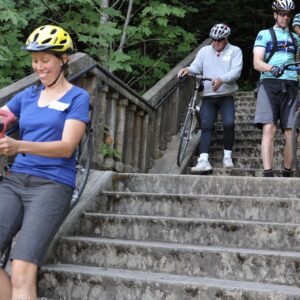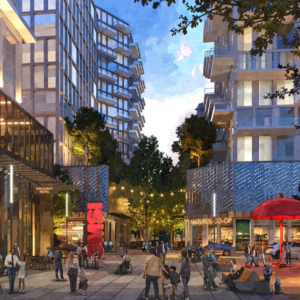
A set of stairs on the Historic Columbia River Highway State Trail that has been the focus of advocates’ ire for many years, has taken a solid step forward.
Built in 1996, before the Oregon Department of Transportation integrated ADA design requirements into trail projects, the Eagle Creek staircase is the bane of bike riders, wheelchair users, and anyone who can’t walk or carry their gear down the six flights of stairs near the Bonneville Dam.
This barrier has come into sharper focus in recent years as the Historic Columbia River Highway State Trail inches toward completion. Back in June we shared how a trail advocate hosted a prominent disability rights activist at the location as a way to bring attention to the issue.
Now the issue has gained the attention of U.S Senator Jeff Merkley (D-OR). Merkley is Chair of the Senate Interior Appropriations Subcommittee and was able to include $35 million for 22 Oregon projects and programs in the FY24 Senate Interior, Environment and Related Agencies Appropriations bill. The funding includes $1.33 million for three projects that are on the Oregon Signature Trails list: restorations and improvements in the Wenaha sections of the Blue Mountains Trail; new connectors in the Oakridge-Westfir Mountain Bike System, and an analysis for replacing the Eagle Creek Staircase.
As we reported in January 2021, the Oregon Department of Transportation’s Historic Columbia River Highway Advisory Committee has made replacement of the staircase a top priority. Conceptual drawings shared by that committee show a sweeping ramp along the steep hillside. The estimated cost of the project has skyrocketed since first estimates were made in 2009. The project funded in Merkley’s bill would allow ODOT to do more design and scoping work and arrive at an accurate estimate to make the project more “shovel ready.”
Here’s more from a one-pager on the project created by ODOT:
“Replacing the Eagle Creek Stairs with an accessible facility would be a benefit to all State Trail users. This funding request will bring all stakeholders together to review replacement alternatives and identify the most viable option to removing this ADA barrier while balancing the requirements to protect the scenic, natural, recreational, and cultural resources within the Gorge. This funding would help provide a conceptual design that could then be used to apply for grant funding for full engineering and construction.”
In a statement, Oregon Trails Coalition Director Steph Noll expressed gratitude for Senator Merkley and his colleague, Senator Ron Wyden. “This will address major gaps in Oregon’s Signature Trail network and increase access to the outdoors in communities across Oregon,” Noll said.
The Interior bill passed through committee on July 27th and is expected to go to the full Senate later this year.








Thanks for reading.
BikePortland has served this community with independent community journalism since 2005. We rely on subscriptions from readers like you to survive. Your financial support is vital in keeping this valuable resource alive and well.
Please subscribe today to strengthen and expand our work.
I’ve always been fond of those stairs and will be sad when we destroy another piece of the original Columbia River Historic Highway for the benefit of a handful of users. I don’t understand why we can’t keep the stairs and simply operate a shuttle service, like a Trimet LIFT van etc.
I disagree that it will benefit only a “handful of users.” There isn’t a federal regulation to make public spaces bike accessible, or baby stroller accessible, but there is ADA. ADA can be used as the stick to improve facilities for a lot of varying uses, not only for disabled people. Although as someone who is disabled, I sure appreciate ramps.
It looks like those stairs were built around 1996 when work began on reopening the Columbia Gorge Highway. They aren’t part of the original highway.
https://www.oregonhikers.org/field_guide/Eagle_Creek_Staircase
There are three segments along and near the Historic Columbia RIver Highway (HCRH) which are completely free of vehicular traffic. These segments are nearly 22 miles total (after the future completion of the Mitchell Tunnel trail). This latter Mitchell Tunnel section should come ‘online’ second quarter 2024. This new tunnel is about 15 feet south from the original tunnel built for the highway. The old tunnel is now airspace over I-84. The new tunnel will have 5 windows or adits looking over the Columbia River. You can see construction images of the tunnel at http://www.72km.org/mitcht/the-light.html. A number of miles of the HCRH have been replaced or ‘sidelined’ for the completion of I-84. Recovery of these parts of discarded & remaining road have been repurposed into the three Trail sections of the HCRH. This was initiated in the middle 1980s. To see sections that are bike walk and roll friendly see http://www.gorgepedal.com.
The “original” Columbia River Hwy was built between 1913 and 1922. As noted in the above article, the stairs were built in 1996. The stairs are not an “original” piece of the highway.
And I agree with Lisa, there’s more than “a handful” of users that would benefit from a ramp. I’ve used these stairs, and it’s a pain. The stairs are definitely a big factor in deciding if I want to continue east to Cascade Locks. I’m sure that it’s a factor for others as well, especially since the alternative is to “take the lane” on I-84 through Toothrock Tunnel.
it’s a lovely design and 27 years is old enough to preserve.
Holy cow, finally.
Inch by inch. There are so many invisible people who will be visible on the Historic Columbia River Trail (HCRH) when the connection becomes complete between Yeon trailhead and Cascade Locks. If you stop at any waterfall along the HCRH there many people visiting these sights who have lifelong disabilities, emergent medical disabilities, temporary disabilities, and cognitive disabilities who face this staircase as a barrier to bike, walk, and roll along the incredible trail. There are families with cargo bikes and kids and newbie hikers /.bikers who will using these connected sections as never before. If you go to the Hatfield Tunnel trail section you can see the increasing numbers of All Bodies All Types for recreation enjoying that part of the eastern HCRH trail section. These trails are no longer the province of Lycra clad male cyclists; it is no longer a select few. This will still take 5 to 10 years to accomplish.
Perfectly stated, Doc. As MAMIL rider myself, the stairs aren’t a big deal. But even for my able-bodied spouse and healthy, spritely kids, the stairs are a not insignificant obstacle to enjoyment. For others with any other barriers, it could potentially be a deal breaker.
It’s mindblowing that even in 1996 those stairs could’ve made it off the plans table and into construction. What a terrible “solution”. It probably should’ve made them re-think the point of what they were building.
Super encouraging, thanks for reporting on this!